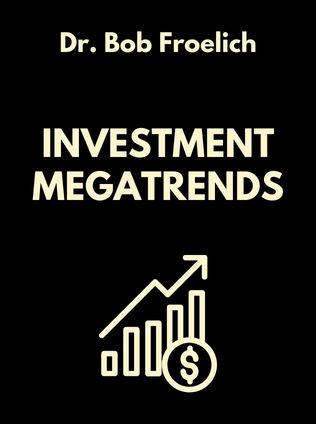
Investment MegaTrends
Go Global and Make Mega-Money While the World Watches and Waits
By Dr. Bob Froelich
Published 01/2006
About the Author
Dr. Bob Froehlich is a distinguished figure in the field of investment and financial strategy. As the vice chairman of Scudder Investments, a division of Deutsche Asset Management, Dr. Froehlich brings a wealth of experience and insight to the world of finance. He serves as the Chairman of the Investor Strategy Committee, the first of its kind on Wall Street, and is a regular commentator on CNBC, Fox, CNN, and Bloomberg. His extensive research and travels around the globe have equipped him with a profound understanding of demographic trends and their impact on global investment opportunities.
Main Idea
Investment Megatrends focuses on identifying and leveraging global demographic shifts to create lucrative investment opportunities. Dr. Froehlich emphasizes the importance of understanding demographic trends, such as the aging population in Japan, the rise of the Chinese consumer, the integration of Eastern European workers into the EU, and the spending power of American baby boomers. These megatrends, though slow to form, have long-lasting effects and can significantly influence investment strategies and outcomes.
Table of Contents
- Understanding the Power of Demographic Trends
- Global Shift 1: The Ponce de Leon Effect - The American Baby Boomers
- Global Shift 2: The Walls Keep Tumbling Down - Eastern European Workers
- Global Shift 3: The Rising Sun is Clearly Setting - The Aging Japanese Population
- Global Shift 4: Napoleon Was Right - The Chinese Consumer Generation
- How to Develop an Investment Megatrends Portfolio
Understanding the Power of Demographic Trends
Demographic trends have been a crucial yet underutilized tool in the investment world. Throughout history, civilizations have collected demographic data, but its potential was not fully understood until the 1960s when governments started tracking comprehensive population statistics. Demographics, at its core, is the study of population change through births, deaths, and migration. These factors, known as the demographic equation, drive all population changes and can be powerful predictors of economic trends and investment opportunities.
Fertility
Fertility, the propensity of women to bear children, is a complex factor influenced by individual choice and government policies. Unlike mortality, which is primarily driven by medical factors, fertility is influenced by a multitude of human factors and societal norms. In analyzing fertility, one must consider the repeated nature of childbearing and the various socio-economic influences that impact a woman’s decision to have children. This makes fertility a critical demographic variable with significant implications for future population growth and economic planning.
Mortality
Mortality rates, the measure of deaths within a population, vary significantly based on age, occupation, and sex. Understanding these variations and their underlying causes is essential for interpreting demographic data and predicting future trends. Mortality rates can reveal much about a population’s health status and its socio-economic conditions. For instance, higher mortality rates in certain occupations may indicate hazardous working conditions, while differences in mortality rates between genders can highlight underlying health disparities. The crude death rate, which measures the total number of deaths in a given period divided by the total population, is a fundamental indicator used in demographic studies.
Migration
Migration, the movement of people between countries, is the most challenging aspect of the demographic equation to measure. It involves complex interactions between multiple countries and can have profound impacts on both the originating and receiving countries' populations. Migration can be driven by a range of factors, including economic opportunities, political instability, and environmental changes. Understanding migration patterns is crucial for forecasting population changes and their potential economic impacts.
Global Shift 1: The Ponce de Leon Effect - The American Baby Boomers
The American Baby Boom Generation, more active and healthier than any previous generation, is now entering its senior years. This demographic shift is characterized by a focus on spending, saving, and investing. Baby boomers are expected to drive significant economic activity in areas such as travel, entertainment, health, and financial services.
Boomer Spend
Baby boomers are significant consumers, outspending other age groups in several key areas:
- Increased spending on food away from home.
- Higher expenditures on transportation and vehicle purchases.
- Greater spending on alcoholic beverages, favoring premium products.
These spending patterns highlight the economic power of baby boomers and their influence on various market sectors. Companies that cater to these preferences are well-positioned to benefit from this demographic trend.
Sign up for FREE and get access to 1,400+ books summaries.
You May Also Like
Rich Dad Poor Dad
What the Rich Teach Their Kids About Money - That the Poor and Middle Class Do Not!
By Robert T. KiyosakiFreakonomics
A Rogue Economist Explores the Hidden Side of Everything
By Steven D. Levitt and Stephen J. DubnerThe Lean Startup
How Today's Entrepreneurs Use Continuous Innovation to Create Radically Successful Businesses
By Eric RiesWho Moved My Cheese?
An Amazing Way to Deal with Change in Your Work and in Your Life
By Spencer Johnson, M.D.Factfulness
Ten Reasons We're Wrong About the World – and Why Things Are Better Than You Think
By Hans RoslingMake Your Bed
Little Things That Can Change Your Life...And Maybe the World
By William H. McRaven



















